Journal Article Analysis: China's 2,500 Years of Economic Thought
VerifiedAdded on 2022/08/18
|20
|8125
|19
Practical Assignment
AI Summary
This practical assignment requires a detailed annotation of Zagros Madjd-Sadjadi's journal article, "China, 2,500 years of economic thought." The article explores the historical and cultural influences on China's economic development, challenging Eurocentric views and highlighting the contributions of Confucianism, Taoism, legalism, and Maoism. The assignment emphasizes critical analysis through annotations, using symbols to mark important vocabulary, relationships between ideas, steps in processes, areas of confusion, humorous parts, supporting details, and opposing viewpoints. The annotations aim to enhance the understanding of Chinese economic thought and its unique blend of collectivist and individualist cultures, examining how these philosophies have shaped the country's economic practices and its interaction with the West. The student must analyze the influence of Chinese culture on its business practices, and evaluate the historical context, regional differences, and the challenges in achieving an equitable and sustainable society.
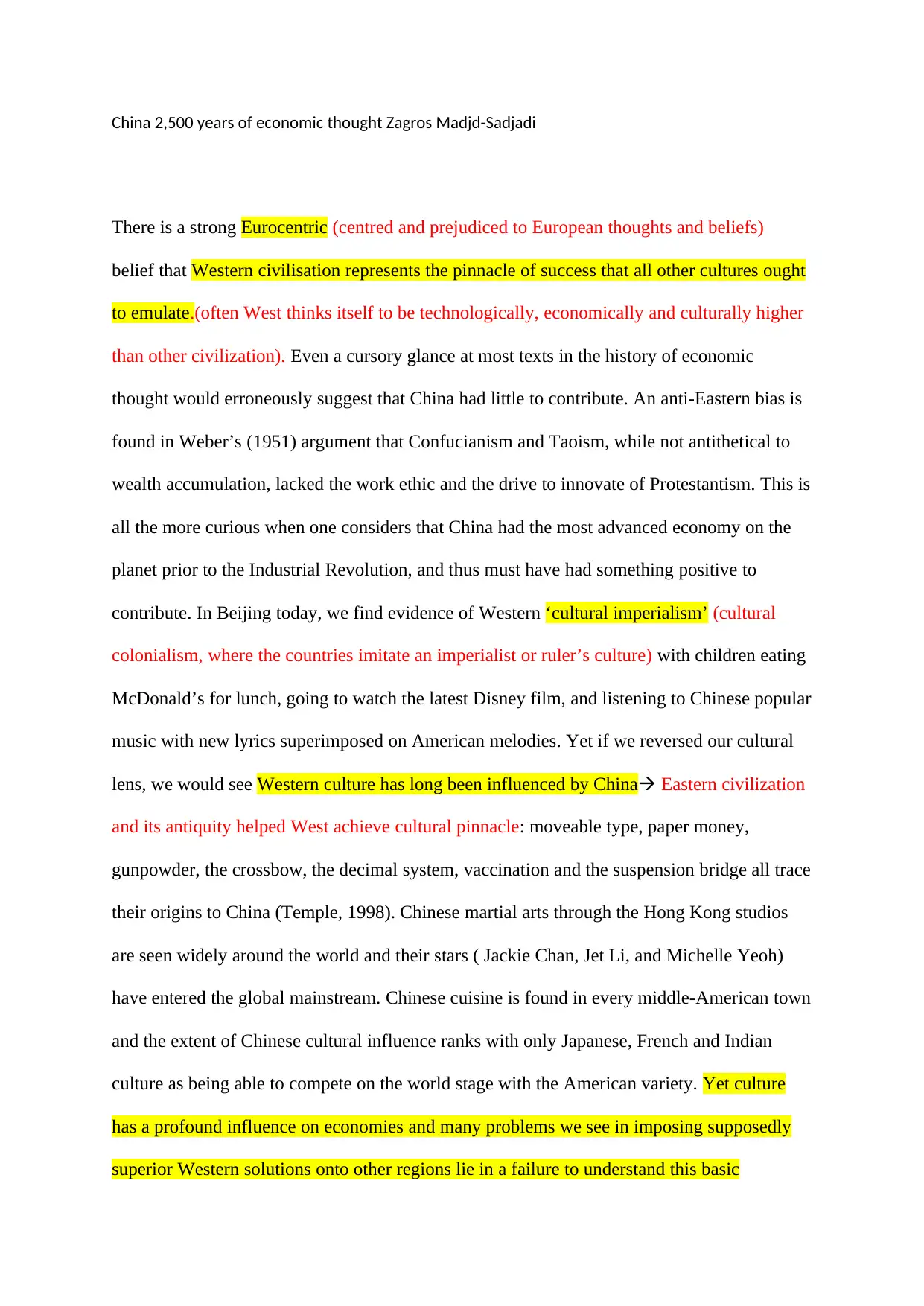
China 2,500 years of economic thought Zagros Madjd-Sadjadi
There is a strong Eurocentric (centred and prejudiced to European thoughts and beliefs)
belief that Western civilisation represents the pinnacle of success that all other cultures ought
to emulate.(often West thinks itself to be technologically, economically and culturally higher
than other civilization). Even a cursory glance at most texts in the history of economic
thought would erroneously suggest that China had little to contribute. An anti-Eastern bias is
found in Weber’s (1951) argument that Confucianism and Taoism, while not antithetical to
wealth accumulation, lacked the work ethic and the drive to innovate of Protestantism. This is
all the more curious when one considers that China had the most advanced economy on the
planet prior to the Industrial Revolution, and thus must have had something positive to
contribute. In Beijing today, we find evidence of Western ‘cultural imperialism’ (cultural
colonialism, where the countries imitate an imperialist or ruler’s culture) with children eating
McDonald’s for lunch, going to watch the latest Disney film, and listening to Chinese popular
music with new lyrics superimposed on American melodies. Yet if we reversed our cultural
lens, we would see Western culture has long been influenced by China Eastern civilization
and its antiquity helped West achieve cultural pinnacle: moveable type, paper money,
gunpowder, the crossbow, the decimal system, vaccination and the suspension bridge all trace
their origins to China (Temple, 1998). Chinese martial arts through the Hong Kong studios
are seen widely around the world and their stars ( Jackie Chan, Jet Li, and Michelle Yeoh)
have entered the global mainstream. Chinese cuisine is found in every middle-American town
and the extent of Chinese cultural influence ranks with only Japanese, French and Indian
culture as being able to compete on the world stage with the American variety. Yet culture
has a profound influence on economies and many problems we see in imposing supposedly
superior Western solutions onto other regions lie in a failure to understand this basic
There is a strong Eurocentric (centred and prejudiced to European thoughts and beliefs)
belief that Western civilisation represents the pinnacle of success that all other cultures ought
to emulate.(often West thinks itself to be technologically, economically and culturally higher
than other civilization). Even a cursory glance at most texts in the history of economic
thought would erroneously suggest that China had little to contribute. An anti-Eastern bias is
found in Weber’s (1951) argument that Confucianism and Taoism, while not antithetical to
wealth accumulation, lacked the work ethic and the drive to innovate of Protestantism. This is
all the more curious when one considers that China had the most advanced economy on the
planet prior to the Industrial Revolution, and thus must have had something positive to
contribute. In Beijing today, we find evidence of Western ‘cultural imperialism’ (cultural
colonialism, where the countries imitate an imperialist or ruler’s culture) with children eating
McDonald’s for lunch, going to watch the latest Disney film, and listening to Chinese popular
music with new lyrics superimposed on American melodies. Yet if we reversed our cultural
lens, we would see Western culture has long been influenced by China Eastern civilization
and its antiquity helped West achieve cultural pinnacle: moveable type, paper money,
gunpowder, the crossbow, the decimal system, vaccination and the suspension bridge all trace
their origins to China (Temple, 1998). Chinese martial arts through the Hong Kong studios
are seen widely around the world and their stars ( Jackie Chan, Jet Li, and Michelle Yeoh)
have entered the global mainstream. Chinese cuisine is found in every middle-American town
and the extent of Chinese cultural influence ranks with only Japanese, French and Indian
culture as being able to compete on the world stage with the American variety. Yet culture
has a profound influence on economies and many problems we see in imposing supposedly
superior Western solutions onto other regions lie in a failure to understand this basic
Paraphrase This Document
Need a fresh take? Get an instant paraphrase of this document with our AI Paraphraser
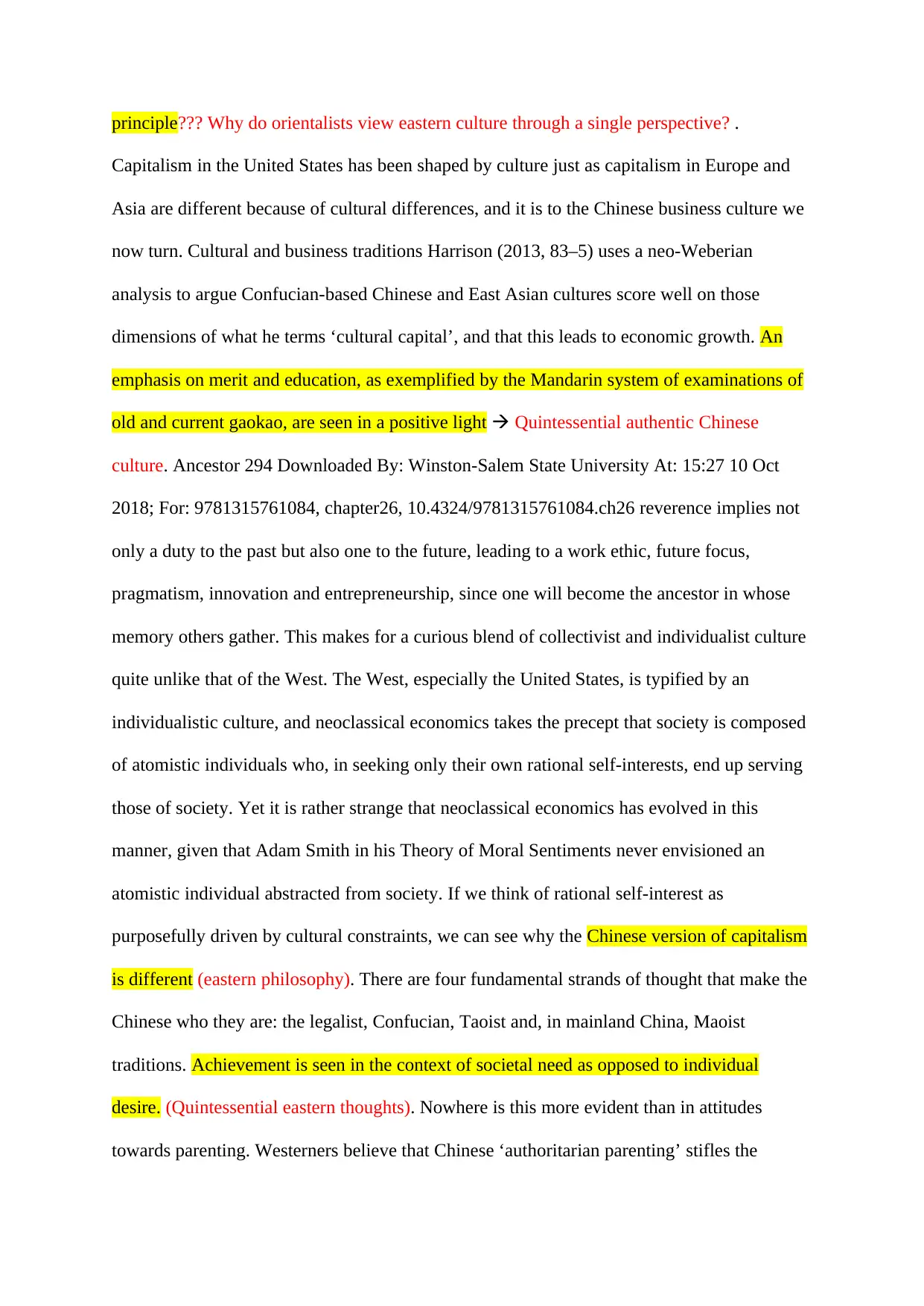
principle??? Why do orientalists view eastern culture through a single perspective? .
Capitalism in the United States has been shaped by culture just as capitalism in Europe and
Asia are different because of cultural differences, and it is to the Chinese business culture we
now turn. Cultural and business traditions Harrison (2013, 83–5) uses a neo-Weberian
analysis to argue Confucian-based Chinese and East Asian cultures score well on those
dimensions of what he terms ‘cultural capital’, and that this leads to economic growth. An
emphasis on merit and education, as exemplified by the Mandarin system of examinations of
old and current gaokao, are seen in a positive light Quintessential authentic Chinese
culture. Ancestor 294 Downloaded By: Winston-Salem State University At: 15:27 10 Oct
2018; For: 9781315761084, chapter26, 10.4324/9781315761084.ch26 reverence implies not
only a duty to the past but also one to the future, leading to a work ethic, future focus,
pragmatism, innovation and entrepreneurship, since one will become the ancestor in whose
memory others gather. This makes for a curious blend of collectivist and individualist culture
quite unlike that of the West. The West, especially the United States, is typified by an
individualistic culture, and neoclassical economics takes the precept that society is composed
of atomistic individuals who, in seeking only their own rational self-interests, end up serving
those of society. Yet it is rather strange that neoclassical economics has evolved in this
manner, given that Adam Smith in his Theory of Moral Sentiments never envisioned an
atomistic individual abstracted from society. If we think of rational self-interest as
purposefully driven by cultural constraints, we can see why the Chinese version of capitalism
is different (eastern philosophy). There are four fundamental strands of thought that make the
Chinese who they are: the legalist, Confucian, Taoist and, in mainland China, Maoist
traditions. Achievement is seen in the context of societal need as opposed to individual
desire. (Quintessential eastern thoughts). Nowhere is this more evident than in attitudes
towards parenting. Westerners believe that Chinese ‘authoritarian parenting’ stifles the
Capitalism in the United States has been shaped by culture just as capitalism in Europe and
Asia are different because of cultural differences, and it is to the Chinese business culture we
now turn. Cultural and business traditions Harrison (2013, 83–5) uses a neo-Weberian
analysis to argue Confucian-based Chinese and East Asian cultures score well on those
dimensions of what he terms ‘cultural capital’, and that this leads to economic growth. An
emphasis on merit and education, as exemplified by the Mandarin system of examinations of
old and current gaokao, are seen in a positive light Quintessential authentic Chinese
culture. Ancestor 294 Downloaded By: Winston-Salem State University At: 15:27 10 Oct
2018; For: 9781315761084, chapter26, 10.4324/9781315761084.ch26 reverence implies not
only a duty to the past but also one to the future, leading to a work ethic, future focus,
pragmatism, innovation and entrepreneurship, since one will become the ancestor in whose
memory others gather. This makes for a curious blend of collectivist and individualist culture
quite unlike that of the West. The West, especially the United States, is typified by an
individualistic culture, and neoclassical economics takes the precept that society is composed
of atomistic individuals who, in seeking only their own rational self-interests, end up serving
those of society. Yet it is rather strange that neoclassical economics has evolved in this
manner, given that Adam Smith in his Theory of Moral Sentiments never envisioned an
atomistic individual abstracted from society. If we think of rational self-interest as
purposefully driven by cultural constraints, we can see why the Chinese version of capitalism
is different (eastern philosophy). There are four fundamental strands of thought that make the
Chinese who they are: the legalist, Confucian, Taoist and, in mainland China, Maoist
traditions. Achievement is seen in the context of societal need as opposed to individual
desire. (Quintessential eastern thoughts). Nowhere is this more evident than in attitudes
towards parenting. Westerners believe that Chinese ‘authoritarian parenting’ stifles the
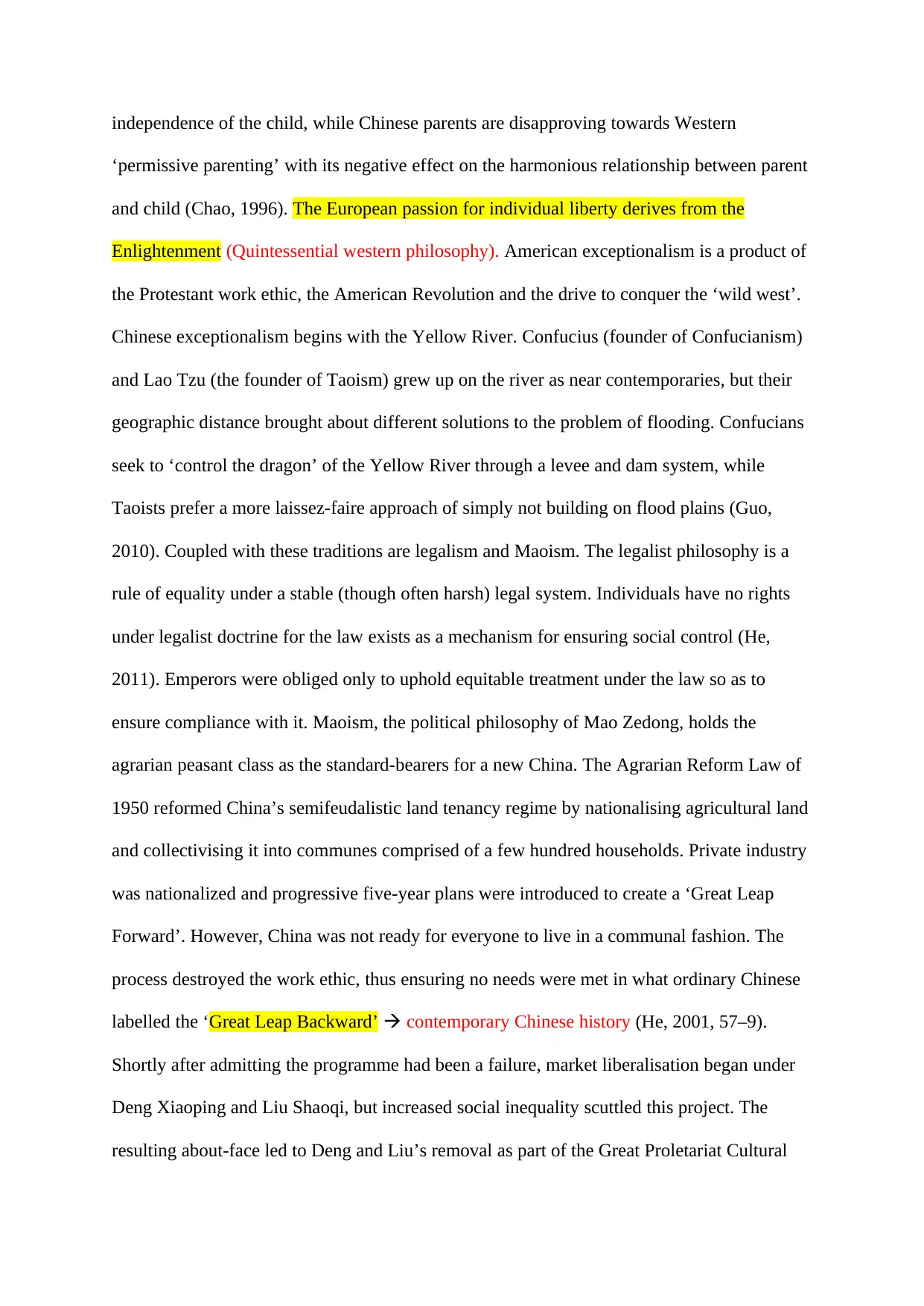
independence of the child, while Chinese parents are disapproving towards Western
‘permissive parenting’ with its negative effect on the harmonious relationship between parent
and child (Chao, 1996). The European passion for individual liberty derives from the
Enlightenment (Quintessential western philosophy). American exceptionalism is a product of
the Protestant work ethic, the American Revolution and the drive to conquer the ‘wild west’.
Chinese exceptionalism begins with the Yellow River. Confucius (founder of Confucianism)
and Lao Tzu (the founder of Taoism) grew up on the river as near contemporaries, but their
geographic distance brought about different solutions to the problem of flooding. Confucians
seek to ‘control the dragon’ of the Yellow River through a levee and dam system, while
Taoists prefer a more laissez-faire approach of simply not building on flood plains (Guo,
2010). Coupled with these traditions are legalism and Maoism. The legalist philosophy is a
rule of equality under a stable (though often harsh) legal system. Individuals have no rights
under legalist doctrine for the law exists as a mechanism for ensuring social control (He,
2011). Emperors were obliged only to uphold equitable treatment under the law so as to
ensure compliance with it. Maoism, the political philosophy of Mao Zedong, holds the
agrarian peasant class as the standard-bearers for a new China. The Agrarian Reform Law of
1950 reformed China’s semifeudalistic land tenancy regime by nationalising agricultural land
and collectivising it into communes comprised of a few hundred households. Private industry
was nationalized and progressive five-year plans were introduced to create a ‘Great Leap
Forward’. However, China was not ready for everyone to live in a communal fashion. The
process destroyed the work ethic, thus ensuring no needs were met in what ordinary Chinese
labelled the ‘Great Leap Backward’ contemporary Chinese history (He, 2001, 57–9).
Shortly after admitting the programme had been a failure, market liberalisation began under
Deng Xiaoping and Liu Shaoqi, but increased social inequality scuttled this project. The
resulting about-face led to Deng and Liu’s removal as part of the Great Proletariat Cultural
‘permissive parenting’ with its negative effect on the harmonious relationship between parent
and child (Chao, 1996). The European passion for individual liberty derives from the
Enlightenment (Quintessential western philosophy). American exceptionalism is a product of
the Protestant work ethic, the American Revolution and the drive to conquer the ‘wild west’.
Chinese exceptionalism begins with the Yellow River. Confucius (founder of Confucianism)
and Lao Tzu (the founder of Taoism) grew up on the river as near contemporaries, but their
geographic distance brought about different solutions to the problem of flooding. Confucians
seek to ‘control the dragon’ of the Yellow River through a levee and dam system, while
Taoists prefer a more laissez-faire approach of simply not building on flood plains (Guo,
2010). Coupled with these traditions are legalism and Maoism. The legalist philosophy is a
rule of equality under a stable (though often harsh) legal system. Individuals have no rights
under legalist doctrine for the law exists as a mechanism for ensuring social control (He,
2011). Emperors were obliged only to uphold equitable treatment under the law so as to
ensure compliance with it. Maoism, the political philosophy of Mao Zedong, holds the
agrarian peasant class as the standard-bearers for a new China. The Agrarian Reform Law of
1950 reformed China’s semifeudalistic land tenancy regime by nationalising agricultural land
and collectivising it into communes comprised of a few hundred households. Private industry
was nationalized and progressive five-year plans were introduced to create a ‘Great Leap
Forward’. However, China was not ready for everyone to live in a communal fashion. The
process destroyed the work ethic, thus ensuring no needs were met in what ordinary Chinese
labelled the ‘Great Leap Backward’ contemporary Chinese history (He, 2001, 57–9).
Shortly after admitting the programme had been a failure, market liberalisation began under
Deng Xiaoping and Liu Shaoqi, but increased social inequality scuttled this project. The
resulting about-face led to Deng and Liu’s removal as part of the Great Proletariat Cultural
⊘ This is a preview!⊘
Do you want full access?
Subscribe today to unlock all pages.

Trusted by 1+ million students worldwide
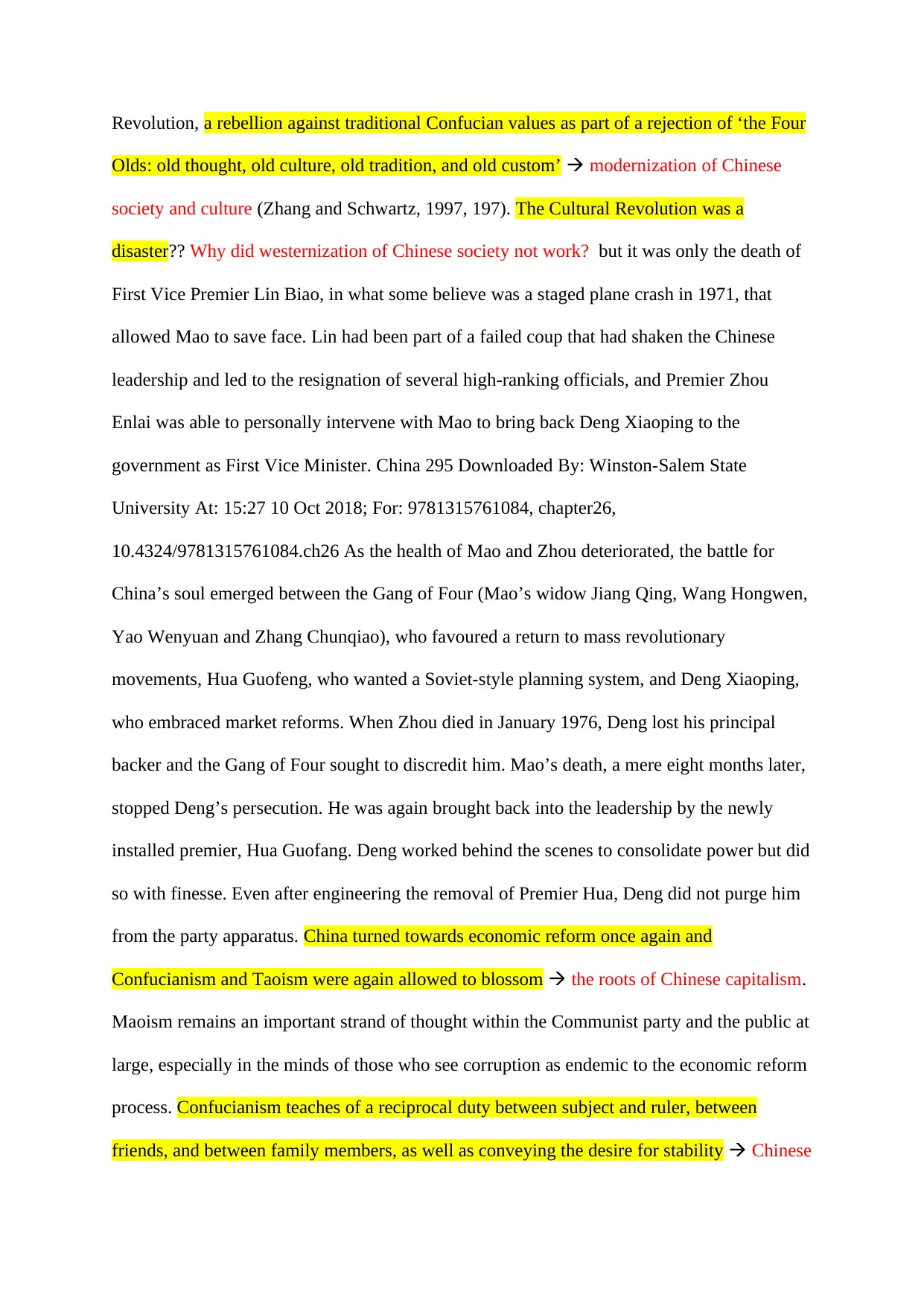
Revolution, a rebellion against traditional Confucian values as part of a rejection of ‘the Four
Olds: old thought, old culture, old tradition, and old custom’ modernization of Chinese
society and culture (Zhang and Schwartz, 1997, 197). The Cultural Revolution was a
disaster?? Why did westernization of Chinese society not work? but it was only the death of
First Vice Premier Lin Biao, in what some believe was a staged plane crash in 1971, that
allowed Mao to save face. Lin had been part of a failed coup that had shaken the Chinese
leadership and led to the resignation of several high-ranking officials, and Premier Zhou
Enlai was able to personally intervene with Mao to bring back Deng Xiaoping to the
government as First Vice Minister. China 295 Downloaded By: Winston-Salem State
University At: 15:27 10 Oct 2018; For: 9781315761084, chapter26,
10.4324/9781315761084.ch26 As the health of Mao and Zhou deteriorated, the battle for
China’s soul emerged between the Gang of Four (Mao’s widow Jiang Qing, Wang Hongwen,
Yao Wenyuan and Zhang Chunqiao), who favoured a return to mass revolutionary
movements, Hua Guofeng, who wanted a Soviet-style planning system, and Deng Xiaoping,
who embraced market reforms. When Zhou died in January 1976, Deng lost his principal
backer and the Gang of Four sought to discredit him. Mao’s death, a mere eight months later,
stopped Deng’s persecution. He was again brought back into the leadership by the newly
installed premier, Hua Guofang. Deng worked behind the scenes to consolidate power but did
so with finesse. Even after engineering the removal of Premier Hua, Deng did not purge him
from the party apparatus. China turned towards economic reform once again and
Confucianism and Taoism were again allowed to blossom the roots of Chinese capitalism.
Maoism remains an important strand of thought within the Communist party and the public at
large, especially in the minds of those who see corruption as endemic to the economic reform
process. Confucianism teaches of a reciprocal duty between subject and ruler, between
friends, and between family members, as well as conveying the desire for stability Chinese
Olds: old thought, old culture, old tradition, and old custom’ modernization of Chinese
society and culture (Zhang and Schwartz, 1997, 197). The Cultural Revolution was a
disaster?? Why did westernization of Chinese society not work? but it was only the death of
First Vice Premier Lin Biao, in what some believe was a staged plane crash in 1971, that
allowed Mao to save face. Lin had been part of a failed coup that had shaken the Chinese
leadership and led to the resignation of several high-ranking officials, and Premier Zhou
Enlai was able to personally intervene with Mao to bring back Deng Xiaoping to the
government as First Vice Minister. China 295 Downloaded By: Winston-Salem State
University At: 15:27 10 Oct 2018; For: 9781315761084, chapter26,
10.4324/9781315761084.ch26 As the health of Mao and Zhou deteriorated, the battle for
China’s soul emerged between the Gang of Four (Mao’s widow Jiang Qing, Wang Hongwen,
Yao Wenyuan and Zhang Chunqiao), who favoured a return to mass revolutionary
movements, Hua Guofeng, who wanted a Soviet-style planning system, and Deng Xiaoping,
who embraced market reforms. When Zhou died in January 1976, Deng lost his principal
backer and the Gang of Four sought to discredit him. Mao’s death, a mere eight months later,
stopped Deng’s persecution. He was again brought back into the leadership by the newly
installed premier, Hua Guofang. Deng worked behind the scenes to consolidate power but did
so with finesse. Even after engineering the removal of Premier Hua, Deng did not purge him
from the party apparatus. China turned towards economic reform once again and
Confucianism and Taoism were again allowed to blossom the roots of Chinese capitalism.
Maoism remains an important strand of thought within the Communist party and the public at
large, especially in the minds of those who see corruption as endemic to the economic reform
process. Confucianism teaches of a reciprocal duty between subject and ruler, between
friends, and between family members, as well as conveying the desire for stability Chinese
Paraphrase This Document
Need a fresh take? Get an instant paraphrase of this document with our AI Paraphraser
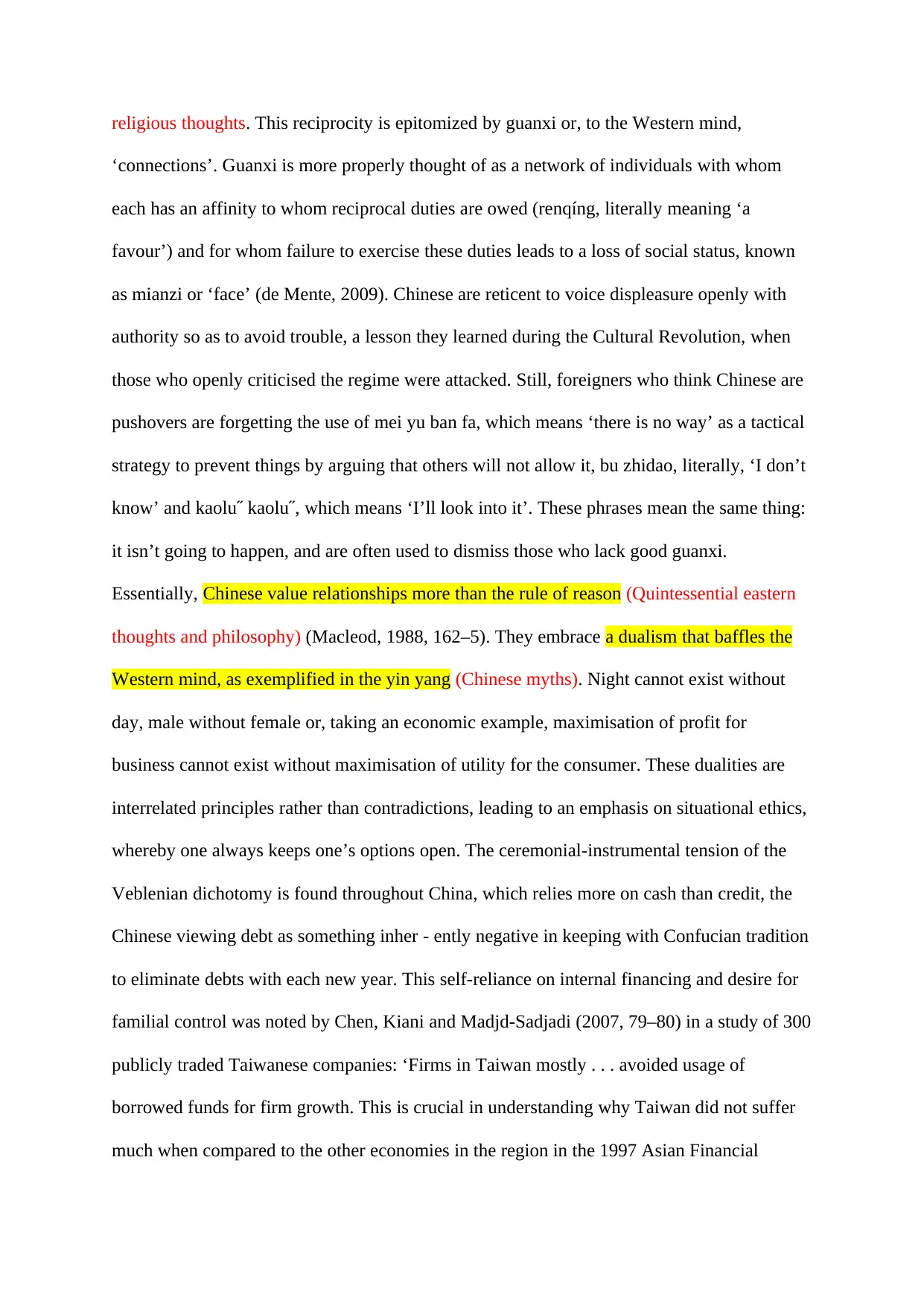
religious thoughts. This reciprocity is epitomized by guanxi or, to the Western mind,
‘connections’. Guanxi is more properly thought of as a network of individuals with whom
each has an affinity to whom reciprocal duties are owed (renqíng, literally meaning ‘a
favour’) and for whom failure to exercise these duties leads to a loss of social status, known
as mianzi or ‘face’ (de Mente, 2009). Chinese are reticent to voice displeasure openly with
authority so as to avoid trouble, a lesson they learned during the Cultural Revolution, when
those who openly criticised the regime were attacked. Still, foreigners who think Chinese are
pushovers are forgetting the use of mei yu ban fa, which means ‘there is no way’ as a tactical
strategy to prevent things by arguing that others will not allow it, bu zhidao, literally, ‘I don’t
know’ and kaolu˝ kaolu˝, which means ‘I’ll look into it’. These phrases mean the same thing:
it isn’t going to happen, and are often used to dismiss those who lack good guanxi.
Essentially, Chinese value relationships more than the rule of reason (Quintessential eastern
thoughts and philosophy) (Macleod, 1988, 162–5). They embrace a dualism that baffles the
Western mind, as exemplified in the yin yang (Chinese myths). Night cannot exist without
day, male without female or, taking an economic example, maximisation of profit for
business cannot exist without maximisation of utility for the consumer. These dualities are
interrelated principles rather than contradictions, leading to an emphasis on situational ethics,
whereby one always keeps one’s options open. The ceremonial-instrumental tension of the
Veblenian dichotomy is found throughout China, which relies more on cash than credit, the
Chinese viewing debt as something inher - ently negative in keeping with Confucian tradition
to eliminate debts with each new year. This self-reliance on internal financing and desire for
familial control was noted by Chen, Kiani and Madjd-Sadjadi (2007, 79–80) in a study of 300
publicly traded Taiwanese companies: ‘Firms in Taiwan mostly . . . avoided usage of
borrowed funds for firm growth. This is crucial in understanding why Taiwan did not suffer
much when compared to the other economies in the region in the 1997 Asian Financial
‘connections’. Guanxi is more properly thought of as a network of individuals with whom
each has an affinity to whom reciprocal duties are owed (renqíng, literally meaning ‘a
favour’) and for whom failure to exercise these duties leads to a loss of social status, known
as mianzi or ‘face’ (de Mente, 2009). Chinese are reticent to voice displeasure openly with
authority so as to avoid trouble, a lesson they learned during the Cultural Revolution, when
those who openly criticised the regime were attacked. Still, foreigners who think Chinese are
pushovers are forgetting the use of mei yu ban fa, which means ‘there is no way’ as a tactical
strategy to prevent things by arguing that others will not allow it, bu zhidao, literally, ‘I don’t
know’ and kaolu˝ kaolu˝, which means ‘I’ll look into it’. These phrases mean the same thing:
it isn’t going to happen, and are often used to dismiss those who lack good guanxi.
Essentially, Chinese value relationships more than the rule of reason (Quintessential eastern
thoughts and philosophy) (Macleod, 1988, 162–5). They embrace a dualism that baffles the
Western mind, as exemplified in the yin yang (Chinese myths). Night cannot exist without
day, male without female or, taking an economic example, maximisation of profit for
business cannot exist without maximisation of utility for the consumer. These dualities are
interrelated principles rather than contradictions, leading to an emphasis on situational ethics,
whereby one always keeps one’s options open. The ceremonial-instrumental tension of the
Veblenian dichotomy is found throughout China, which relies more on cash than credit, the
Chinese viewing debt as something inher - ently negative in keeping with Confucian tradition
to eliminate debts with each new year. This self-reliance on internal financing and desire for
familial control was noted by Chen, Kiani and Madjd-Sadjadi (2007, 79–80) in a study of 300
publicly traded Taiwanese companies: ‘Firms in Taiwan mostly . . . avoided usage of
borrowed funds for firm growth. This is crucial in understanding why Taiwan did not suffer
much when compared to the other economies in the region in the 1997 Asian Financial
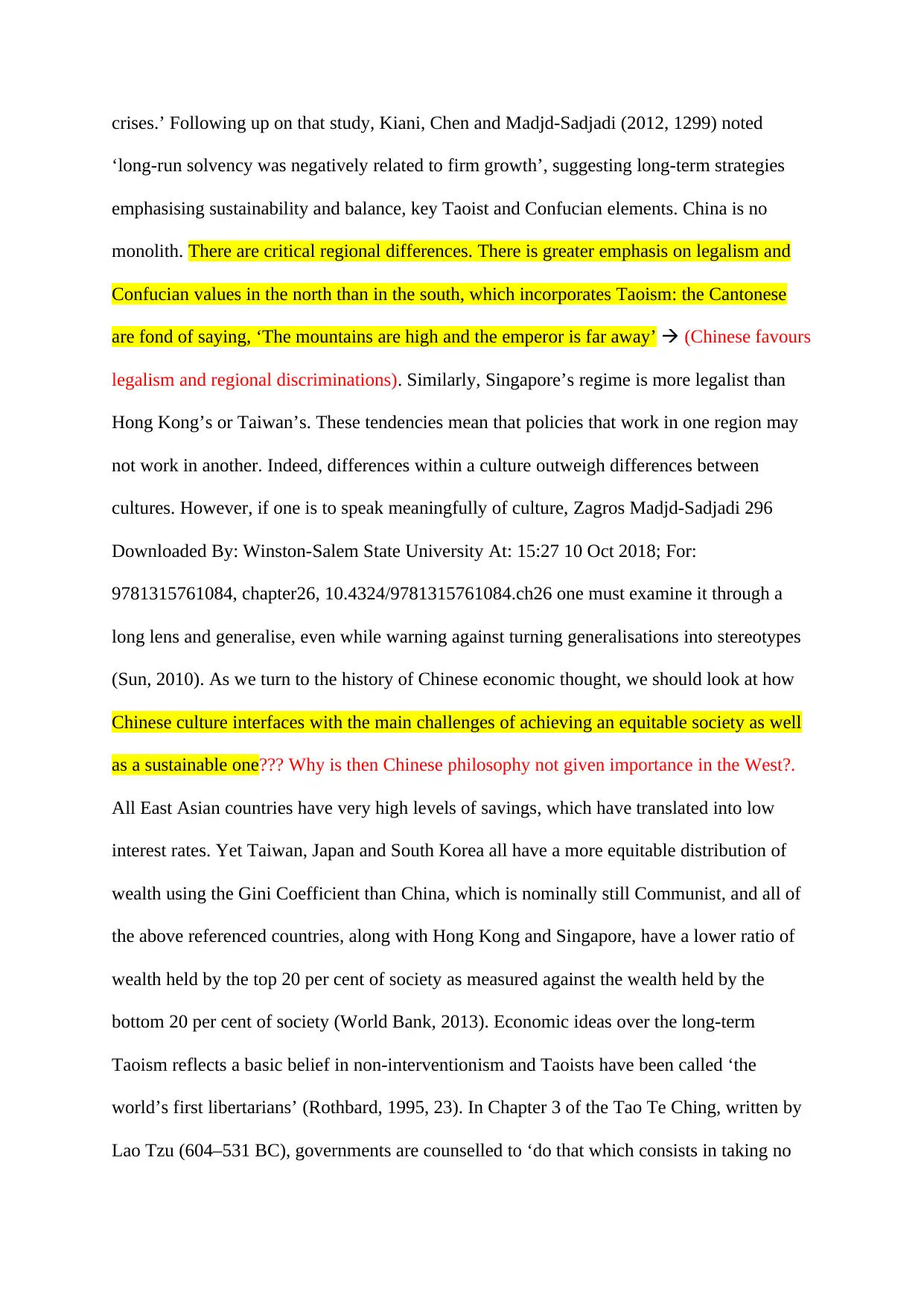
crises.’ Following up on that study, Kiani, Chen and Madjd-Sadjadi (2012, 1299) noted
‘long-run solvency was negatively related to firm growth’, suggesting long-term strategies
emphasising sustainability and balance, key Taoist and Confucian elements. China is no
monolith. There are critical regional differences. There is greater emphasis on legalism and
Confucian values in the north than in the south, which incorporates Taoism: the Cantonese
are fond of saying, ‘The mountains are high and the emperor is far away’ (Chinese favours
legalism and regional discriminations). Similarly, Singapore’s regime is more legalist than
Hong Kong’s or Taiwan’s. These tendencies mean that policies that work in one region may
not work in another. Indeed, differences within a culture outweigh differences between
cultures. However, if one is to speak meaningfully of culture, Zagros Madjd-Sadjadi 296
Downloaded By: Winston-Salem State University At: 15:27 10 Oct 2018; For:
9781315761084, chapter26, 10.4324/9781315761084.ch26 one must examine it through a
long lens and generalise, even while warning against turning generalisations into stereotypes
(Sun, 2010). As we turn to the history of Chinese economic thought, we should look at how
Chinese culture interfaces with the main challenges of achieving an equitable society as well
as a sustainable one??? Why is then Chinese philosophy not given importance in the West?.
All East Asian countries have very high levels of savings, which have translated into low
interest rates. Yet Taiwan, Japan and South Korea all have a more equitable distribution of
wealth using the Gini Coefficient than China, which is nominally still Communist, and all of
the above referenced countries, along with Hong Kong and Singapore, have a lower ratio of
wealth held by the top 20 per cent of society as measured against the wealth held by the
bottom 20 per cent of society (World Bank, 2013). Economic ideas over the long-term
Taoism reflects a basic belief in non-interventionism and Taoists have been called ‘the
world’s first libertarians’ (Rothbard, 1995, 23). In Chapter 3 of the Tao Te Ching, written by
Lao Tzu (604–531 BC), governments are counselled to ‘do that which consists in taking no
‘long-run solvency was negatively related to firm growth’, suggesting long-term strategies
emphasising sustainability and balance, key Taoist and Confucian elements. China is no
monolith. There are critical regional differences. There is greater emphasis on legalism and
Confucian values in the north than in the south, which incorporates Taoism: the Cantonese
are fond of saying, ‘The mountains are high and the emperor is far away’ (Chinese favours
legalism and regional discriminations). Similarly, Singapore’s regime is more legalist than
Hong Kong’s or Taiwan’s. These tendencies mean that policies that work in one region may
not work in another. Indeed, differences within a culture outweigh differences between
cultures. However, if one is to speak meaningfully of culture, Zagros Madjd-Sadjadi 296
Downloaded By: Winston-Salem State University At: 15:27 10 Oct 2018; For:
9781315761084, chapter26, 10.4324/9781315761084.ch26 one must examine it through a
long lens and generalise, even while warning against turning generalisations into stereotypes
(Sun, 2010). As we turn to the history of Chinese economic thought, we should look at how
Chinese culture interfaces with the main challenges of achieving an equitable society as well
as a sustainable one??? Why is then Chinese philosophy not given importance in the West?.
All East Asian countries have very high levels of savings, which have translated into low
interest rates. Yet Taiwan, Japan and South Korea all have a more equitable distribution of
wealth using the Gini Coefficient than China, which is nominally still Communist, and all of
the above referenced countries, along with Hong Kong and Singapore, have a lower ratio of
wealth held by the top 20 per cent of society as measured against the wealth held by the
bottom 20 per cent of society (World Bank, 2013). Economic ideas over the long-term
Taoism reflects a basic belief in non-interventionism and Taoists have been called ‘the
world’s first libertarians’ (Rothbard, 1995, 23). In Chapter 3 of the Tao Te Ching, written by
Lao Tzu (604–531 BC), governments are counselled to ‘do that which consists in taking no
⊘ This is a preview!⊘
Do you want full access?
Subscribe today to unlock all pages.

Trusted by 1+ million students worldwide
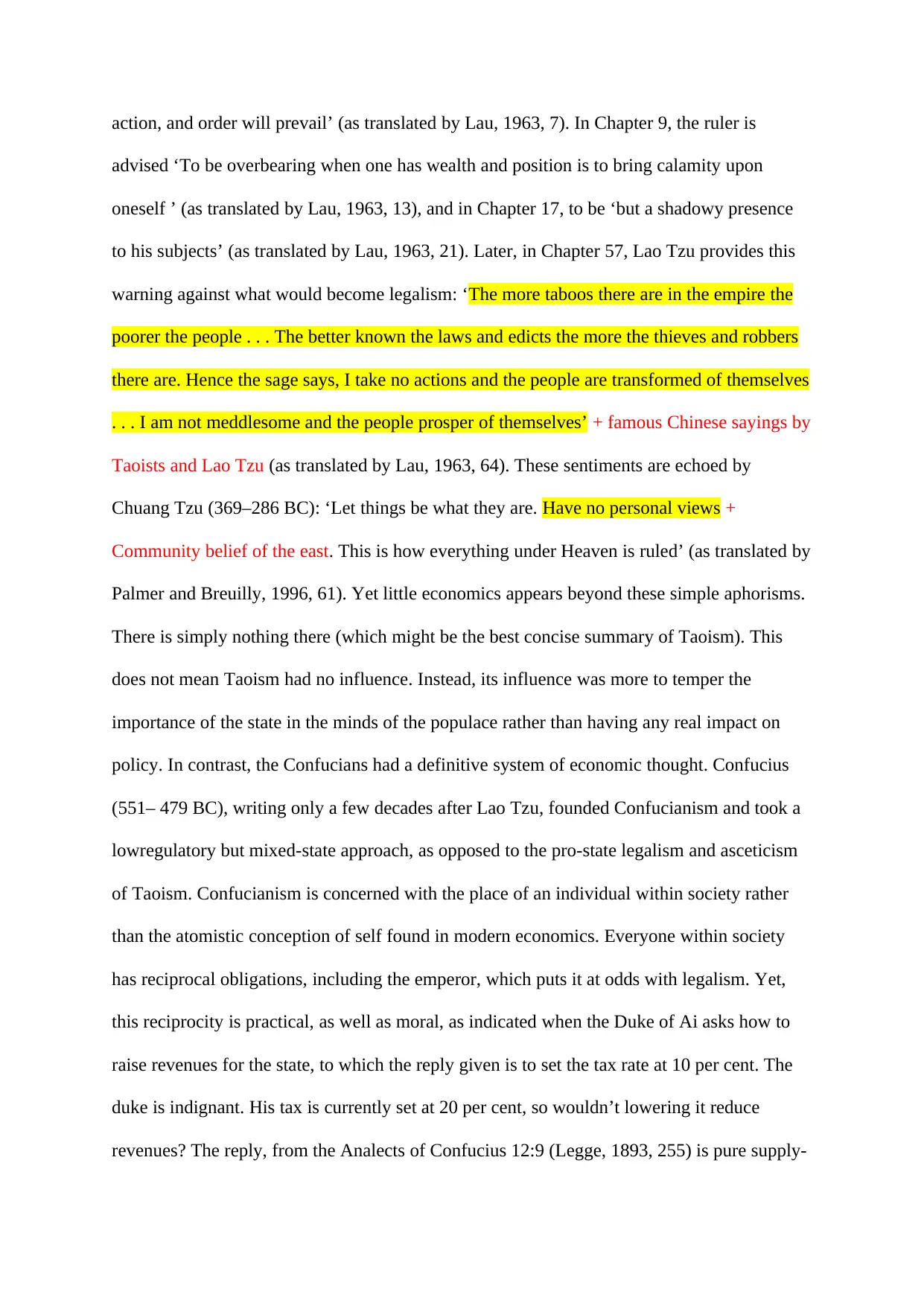
action, and order will prevail’ (as translated by Lau, 1963, 7). In Chapter 9, the ruler is
advised ‘To be overbearing when one has wealth and position is to bring calamity upon
oneself ’ (as translated by Lau, 1963, 13), and in Chapter 17, to be ‘but a shadowy presence
to his subjects’ (as translated by Lau, 1963, 21). Later, in Chapter 57, Lao Tzu provides this
warning against what would become legalism: ‘The more taboos there are in the empire the
poorer the people . . . The better known the laws and edicts the more the thieves and robbers
there are. Hence the sage says, I take no actions and the people are transformed of themselves
. . . I am not meddlesome and the people prosper of themselves’ + famous Chinese sayings by
Taoists and Lao Tzu (as translated by Lau, 1963, 64). These sentiments are echoed by
Chuang Tzu (369–286 BC): ‘Let things be what they are. Have no personal views +
Community belief of the east. This is how everything under Heaven is ruled’ (as translated by
Palmer and Breuilly, 1996, 61). Yet little economics appears beyond these simple aphorisms.
There is simply nothing there (which might be the best concise summary of Taoism). This
does not mean Taoism had no influence. Instead, its influence was more to temper the
importance of the state in the minds of the populace rather than having any real impact on
policy. In contrast, the Confucians had a definitive system of economic thought. Confucius
(551– 479 BC), writing only a few decades after Lao Tzu, founded Confucianism and took a
lowregulatory but mixed-state approach, as opposed to the pro-state legalism and asceticism
of Taoism. Confucianism is concerned with the place of an individual within society rather
than the atomistic conception of self found in modern economics. Everyone within society
has reciprocal obligations, including the emperor, which puts it at odds with legalism. Yet,
this reciprocity is practical, as well as moral, as indicated when the Duke of Ai asks how to
raise revenues for the state, to which the reply given is to set the tax rate at 10 per cent. The
duke is indignant. His tax is currently set at 20 per cent, so wouldn’t lowering it reduce
revenues? The reply, from the Analects of Confucius 12:9 (Legge, 1893, 255) is pure supply-
advised ‘To be overbearing when one has wealth and position is to bring calamity upon
oneself ’ (as translated by Lau, 1963, 13), and in Chapter 17, to be ‘but a shadowy presence
to his subjects’ (as translated by Lau, 1963, 21). Later, in Chapter 57, Lao Tzu provides this
warning against what would become legalism: ‘The more taboos there are in the empire the
poorer the people . . . The better known the laws and edicts the more the thieves and robbers
there are. Hence the sage says, I take no actions and the people are transformed of themselves
. . . I am not meddlesome and the people prosper of themselves’ + famous Chinese sayings by
Taoists and Lao Tzu (as translated by Lau, 1963, 64). These sentiments are echoed by
Chuang Tzu (369–286 BC): ‘Let things be what they are. Have no personal views +
Community belief of the east. This is how everything under Heaven is ruled’ (as translated by
Palmer and Breuilly, 1996, 61). Yet little economics appears beyond these simple aphorisms.
There is simply nothing there (which might be the best concise summary of Taoism). This
does not mean Taoism had no influence. Instead, its influence was more to temper the
importance of the state in the minds of the populace rather than having any real impact on
policy. In contrast, the Confucians had a definitive system of economic thought. Confucius
(551– 479 BC), writing only a few decades after Lao Tzu, founded Confucianism and took a
lowregulatory but mixed-state approach, as opposed to the pro-state legalism and asceticism
of Taoism. Confucianism is concerned with the place of an individual within society rather
than the atomistic conception of self found in modern economics. Everyone within society
has reciprocal obligations, including the emperor, which puts it at odds with legalism. Yet,
this reciprocity is practical, as well as moral, as indicated when the Duke of Ai asks how to
raise revenues for the state, to which the reply given is to set the tax rate at 10 per cent. The
duke is indignant. His tax is currently set at 20 per cent, so wouldn’t lowering it reduce
revenues? The reply, from the Analects of Confucius 12:9 (Legge, 1893, 255) is pure supply-
Paraphrase This Document
Need a fresh take? Get an instant paraphrase of this document with our AI Paraphraser
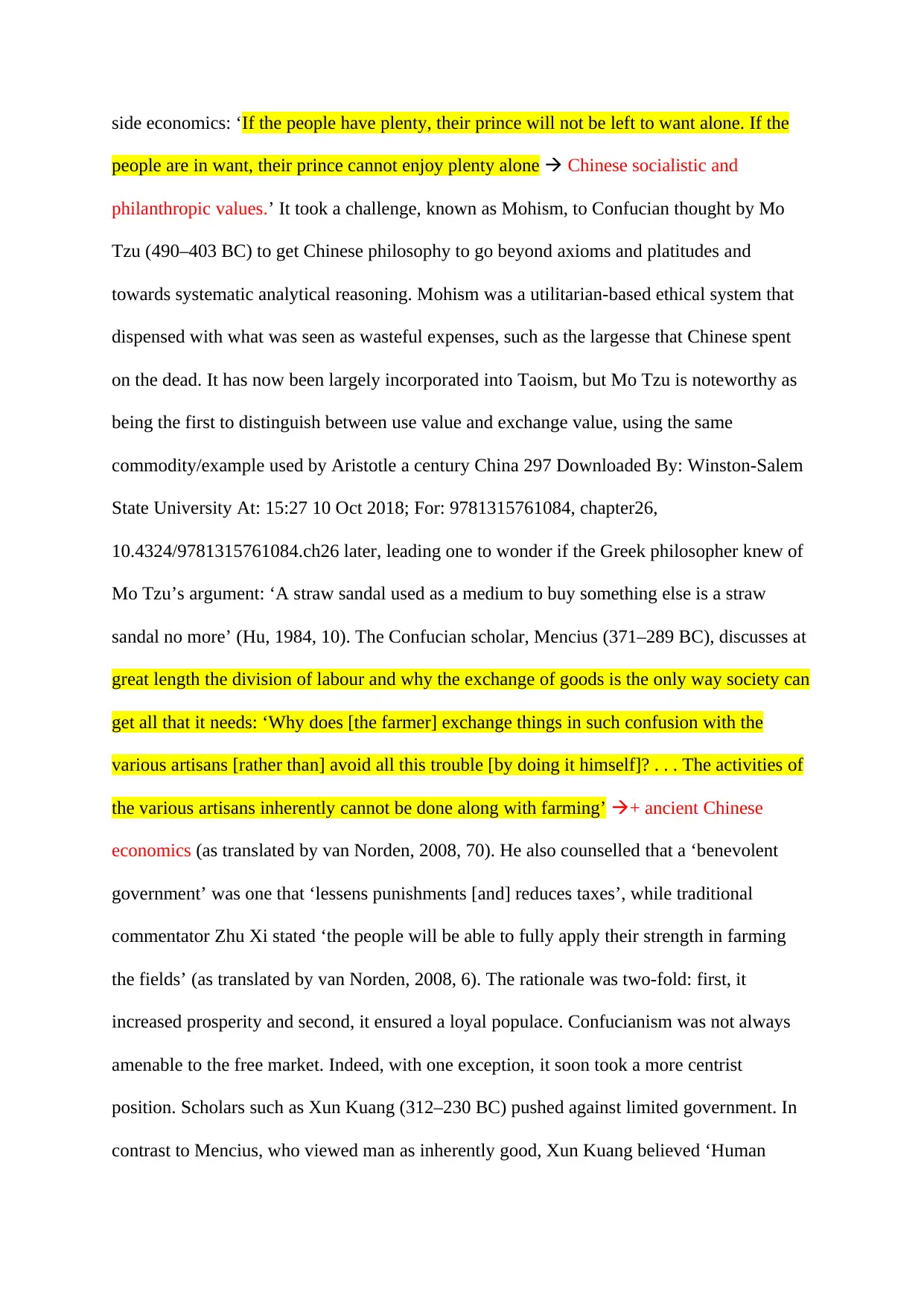
side economics: ‘If the people have plenty, their prince will not be left to want alone. If the
people are in want, their prince cannot enjoy plenty alone Chinese socialistic and
philanthropic values.’ It took a challenge, known as Mohism, to Confucian thought by Mo
Tzu (490–403 BC) to get Chinese philosophy to go beyond axioms and platitudes and
towards systematic analytical reasoning. Mohism was a utilitarian-based ethical system that
dispensed with what was seen as wasteful expenses, such as the largesse that Chinese spent
on the dead. It has now been largely incorporated into Taoism, but Mo Tzu is noteworthy as
being the first to distinguish between use value and exchange value, using the same
commodity/example used by Aristotle a century China 297 Downloaded By: Winston-Salem
State University At: 15:27 10 Oct 2018; For: 9781315761084, chapter26,
10.4324/9781315761084.ch26 later, leading one to wonder if the Greek philosopher knew of
Mo Tzu’s argument: ‘A straw sandal used as a medium to buy something else is a straw
sandal no more’ (Hu, 1984, 10). The Confucian scholar, Mencius (371–289 BC), discusses at
great length the division of labour and why the exchange of goods is the only way society can
get all that it needs: ‘Why does [the farmer] exchange things in such confusion with the
various artisans [rather than] avoid all this trouble [by doing it himself]? . . . The activities of
the various artisans inherently cannot be done along with farming’ + ancient Chinese
economics (as translated by van Norden, 2008, 70). He also counselled that a ‘benevolent
government’ was one that ‘lessens punishments [and] reduces taxes’, while traditional
commentator Zhu Xi stated ‘the people will be able to fully apply their strength in farming
the fields’ (as translated by van Norden, 2008, 6). The rationale was two-fold: first, it
increased prosperity and second, it ensured a loyal populace. Confucianism was not always
amenable to the free market. Indeed, with one exception, it soon took a more centrist
position. Scholars such as Xun Kuang (312–230 BC) pushed against limited government. In
contrast to Mencius, who viewed man as inherently good, Xun Kuang believed ‘Human
people are in want, their prince cannot enjoy plenty alone Chinese socialistic and
philanthropic values.’ It took a challenge, known as Mohism, to Confucian thought by Mo
Tzu (490–403 BC) to get Chinese philosophy to go beyond axioms and platitudes and
towards systematic analytical reasoning. Mohism was a utilitarian-based ethical system that
dispensed with what was seen as wasteful expenses, such as the largesse that Chinese spent
on the dead. It has now been largely incorporated into Taoism, but Mo Tzu is noteworthy as
being the first to distinguish between use value and exchange value, using the same
commodity/example used by Aristotle a century China 297 Downloaded By: Winston-Salem
State University At: 15:27 10 Oct 2018; For: 9781315761084, chapter26,
10.4324/9781315761084.ch26 later, leading one to wonder if the Greek philosopher knew of
Mo Tzu’s argument: ‘A straw sandal used as a medium to buy something else is a straw
sandal no more’ (Hu, 1984, 10). The Confucian scholar, Mencius (371–289 BC), discusses at
great length the division of labour and why the exchange of goods is the only way society can
get all that it needs: ‘Why does [the farmer] exchange things in such confusion with the
various artisans [rather than] avoid all this trouble [by doing it himself]? . . . The activities of
the various artisans inherently cannot be done along with farming’ + ancient Chinese
economics (as translated by van Norden, 2008, 70). He also counselled that a ‘benevolent
government’ was one that ‘lessens punishments [and] reduces taxes’, while traditional
commentator Zhu Xi stated ‘the people will be able to fully apply their strength in farming
the fields’ (as translated by van Norden, 2008, 6). The rationale was two-fold: first, it
increased prosperity and second, it ensured a loyal populace. Confucianism was not always
amenable to the free market. Indeed, with one exception, it soon took a more centrist
position. Scholars such as Xun Kuang (312–230 BC) pushed against limited government. In
contrast to Mencius, who viewed man as inherently good, Xun Kuang believed ‘Human
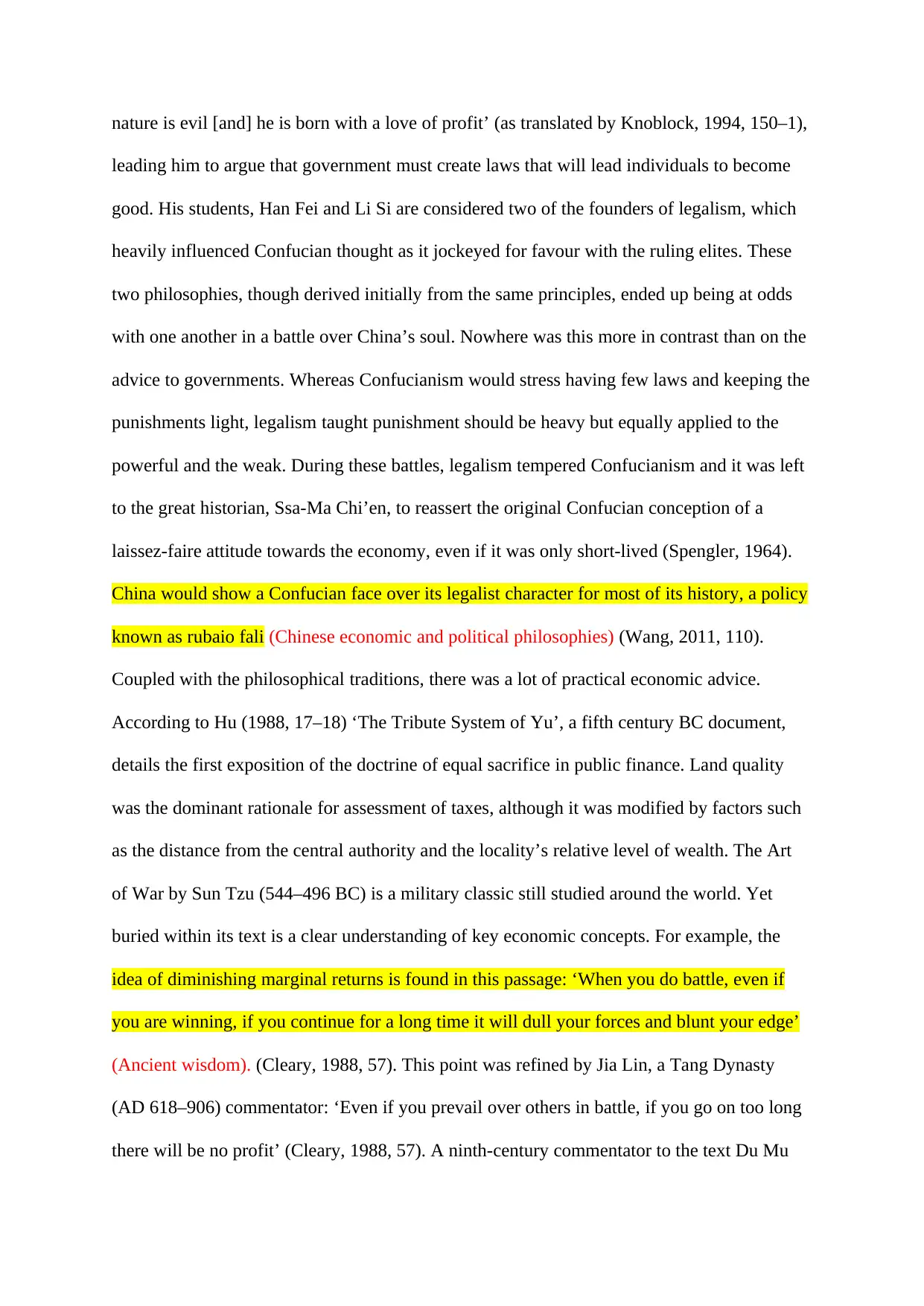
nature is evil [and] he is born with a love of profit’ (as translated by Knoblock, 1994, 150–1),
leading him to argue that government must create laws that will lead individuals to become
good. His students, Han Fei and Li Si are considered two of the founders of legalism, which
heavily influenced Confucian thought as it jockeyed for favour with the ruling elites. These
two philosophies, though derived initially from the same principles, ended up being at odds
with one another in a battle over China’s soul. Nowhere was this more in contrast than on the
advice to governments. Whereas Confucianism would stress having few laws and keeping the
punishments light, legalism taught punishment should be heavy but equally applied to the
powerful and the weak. During these battles, legalism tempered Confucianism and it was left
to the great historian, Ssa-Ma Chi’en, to reassert the original Confucian conception of a
laissez-faire attitude towards the economy, even if it was only short-lived (Spengler, 1964).
China would show a Confucian face over its legalist character for most of its history, a policy
known as rubaio fali (Chinese economic and political philosophies) (Wang, 2011, 110).
Coupled with the philosophical traditions, there was a lot of practical economic advice.
According to Hu (1988, 17–18) ‘The Tribute System of Yu’, a fifth century BC document,
details the first exposition of the doctrine of equal sacrifice in public finance. Land quality
was the dominant rationale for assessment of taxes, although it was modified by factors such
as the distance from the central authority and the locality’s relative level of wealth. The Art
of War by Sun Tzu (544–496 BC) is a military classic still studied around the world. Yet
buried within its text is a clear understanding of key economic concepts. For example, the
idea of diminishing marginal returns is found in this passage: ‘When you do battle, even if
you are winning, if you continue for a long time it will dull your forces and blunt your edge’
(Ancient wisdom). (Cleary, 1988, 57). This point was refined by Jia Lin, a Tang Dynasty
(AD 618–906) commentator: ‘Even if you prevail over others in battle, if you go on too long
there will be no profit’ (Cleary, 1988, 57). A ninth-century commentator to the text Du Mu
leading him to argue that government must create laws that will lead individuals to become
good. His students, Han Fei and Li Si are considered two of the founders of legalism, which
heavily influenced Confucian thought as it jockeyed for favour with the ruling elites. These
two philosophies, though derived initially from the same principles, ended up being at odds
with one another in a battle over China’s soul. Nowhere was this more in contrast than on the
advice to governments. Whereas Confucianism would stress having few laws and keeping the
punishments light, legalism taught punishment should be heavy but equally applied to the
powerful and the weak. During these battles, legalism tempered Confucianism and it was left
to the great historian, Ssa-Ma Chi’en, to reassert the original Confucian conception of a
laissez-faire attitude towards the economy, even if it was only short-lived (Spengler, 1964).
China would show a Confucian face over its legalist character for most of its history, a policy
known as rubaio fali (Chinese economic and political philosophies) (Wang, 2011, 110).
Coupled with the philosophical traditions, there was a lot of practical economic advice.
According to Hu (1988, 17–18) ‘The Tribute System of Yu’, a fifth century BC document,
details the first exposition of the doctrine of equal sacrifice in public finance. Land quality
was the dominant rationale for assessment of taxes, although it was modified by factors such
as the distance from the central authority and the locality’s relative level of wealth. The Art
of War by Sun Tzu (544–496 BC) is a military classic still studied around the world. Yet
buried within its text is a clear understanding of key economic concepts. For example, the
idea of diminishing marginal returns is found in this passage: ‘When you do battle, even if
you are winning, if you continue for a long time it will dull your forces and blunt your edge’
(Ancient wisdom). (Cleary, 1988, 57). This point was refined by Jia Lin, a Tang Dynasty
(AD 618–906) commentator: ‘Even if you prevail over others in battle, if you go on too long
there will be no profit’ (Cleary, 1988, 57). A ninth-century commentator to the text Du Mu
⊘ This is a preview!⊘
Do you want full access?
Subscribe today to unlock all pages.

Trusted by 1+ million students worldwide
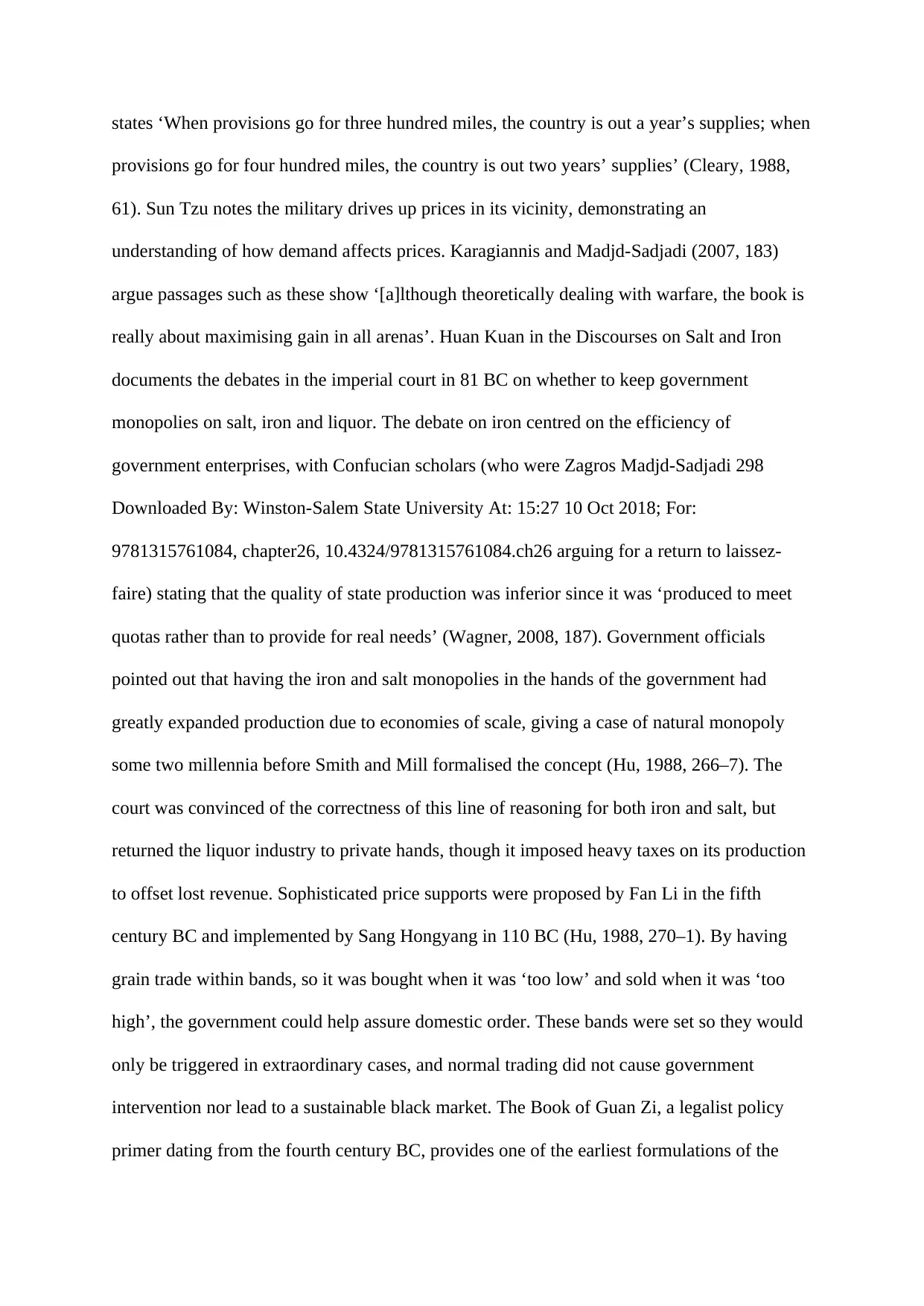
states ‘When provisions go for three hundred miles, the country is out a year’s supplies; when
provisions go for four hundred miles, the country is out two years’ supplies’ (Cleary, 1988,
61). Sun Tzu notes the military drives up prices in its vicinity, demonstrating an
understanding of how demand affects prices. Karagiannis and Madjd-Sadjadi (2007, 183)
argue passages such as these show ‘[a]lthough theoretically dealing with warfare, the book is
really about maximising gain in all arenas’. Huan Kuan in the Discourses on Salt and Iron
documents the debates in the imperial court in 81 BC on whether to keep government
monopolies on salt, iron and liquor. The debate on iron centred on the efficiency of
government enterprises, with Confucian scholars (who were Zagros Madjd-Sadjadi 298
Downloaded By: Winston-Salem State University At: 15:27 10 Oct 2018; For:
9781315761084, chapter26, 10.4324/9781315761084.ch26 arguing for a return to laissez-
faire) stating that the quality of state production was inferior since it was ‘produced to meet
quotas rather than to provide for real needs’ (Wagner, 2008, 187). Government officials
pointed out that having the iron and salt monopolies in the hands of the government had
greatly expanded production due to economies of scale, giving a case of natural monopoly
some two millennia before Smith and Mill formalised the concept (Hu, 1988, 266–7). The
court was convinced of the correctness of this line of reasoning for both iron and salt, but
returned the liquor industry to private hands, though it imposed heavy taxes on its production
to offset lost revenue. Sophisticated price supports were proposed by Fan Li in the fifth
century BC and implemented by Sang Hongyang in 110 BC (Hu, 1988, 270–1). By having
grain trade within bands, so it was bought when it was ‘too low’ and sold when it was ‘too
high’, the government could help assure domestic order. These bands were set so they would
only be triggered in extraordinary cases, and normal trading did not cause government
intervention nor lead to a sustainable black market. The Book of Guan Zi, a legalist policy
primer dating from the fourth century BC, provides one of the earliest formulations of the
provisions go for four hundred miles, the country is out two years’ supplies’ (Cleary, 1988,
61). Sun Tzu notes the military drives up prices in its vicinity, demonstrating an
understanding of how demand affects prices. Karagiannis and Madjd-Sadjadi (2007, 183)
argue passages such as these show ‘[a]lthough theoretically dealing with warfare, the book is
really about maximising gain in all arenas’. Huan Kuan in the Discourses on Salt and Iron
documents the debates in the imperial court in 81 BC on whether to keep government
monopolies on salt, iron and liquor. The debate on iron centred on the efficiency of
government enterprises, with Confucian scholars (who were Zagros Madjd-Sadjadi 298
Downloaded By: Winston-Salem State University At: 15:27 10 Oct 2018; For:
9781315761084, chapter26, 10.4324/9781315761084.ch26 arguing for a return to laissez-
faire) stating that the quality of state production was inferior since it was ‘produced to meet
quotas rather than to provide for real needs’ (Wagner, 2008, 187). Government officials
pointed out that having the iron and salt monopolies in the hands of the government had
greatly expanded production due to economies of scale, giving a case of natural monopoly
some two millennia before Smith and Mill formalised the concept (Hu, 1988, 266–7). The
court was convinced of the correctness of this line of reasoning for both iron and salt, but
returned the liquor industry to private hands, though it imposed heavy taxes on its production
to offset lost revenue. Sophisticated price supports were proposed by Fan Li in the fifth
century BC and implemented by Sang Hongyang in 110 BC (Hu, 1988, 270–1). By having
grain trade within bands, so it was bought when it was ‘too low’ and sold when it was ‘too
high’, the government could help assure domestic order. These bands were set so they would
only be triggered in extraordinary cases, and normal trading did not cause government
intervention nor lead to a sustainable black market. The Book of Guan Zi, a legalist policy
primer dating from the fourth century BC, provides one of the earliest formulations of the
Paraphrase This Document
Need a fresh take? Get an instant paraphrase of this document with our AI Paraphraser
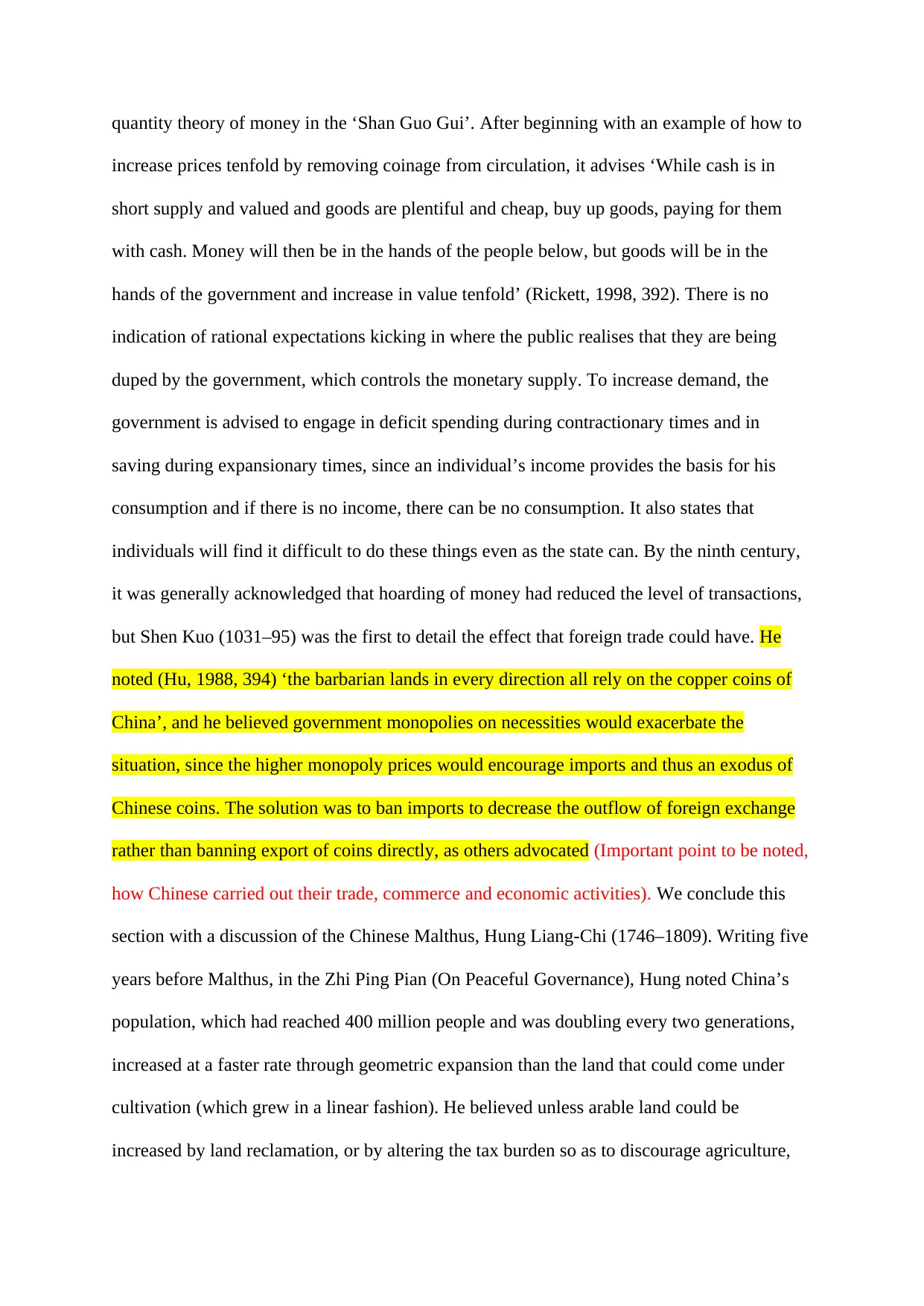
quantity theory of money in the ‘Shan Guo Gui’. After beginning with an example of how to
increase prices tenfold by removing coinage from circulation, it advises ‘While cash is in
short supply and valued and goods are plentiful and cheap, buy up goods, paying for them
with cash. Money will then be in the hands of the people below, but goods will be in the
hands of the government and increase in value tenfold’ (Rickett, 1998, 392). There is no
indication of rational expectations kicking in where the public realises that they are being
duped by the government, which controls the monetary supply. To increase demand, the
government is advised to engage in deficit spending during contractionary times and in
saving during expansionary times, since an individual’s income provides the basis for his
consumption and if there is no income, there can be no consumption. It also states that
individuals will find it difficult to do these things even as the state can. By the ninth century,
it was generally acknowledged that hoarding of money had reduced the level of transactions,
but Shen Kuo (1031–95) was the first to detail the effect that foreign trade could have. He
noted (Hu, 1988, 394) ‘the barbarian lands in every direction all rely on the copper coins of
China’, and he believed government monopolies on necessities would exacerbate the
situation, since the higher monopoly prices would encourage imports and thus an exodus of
Chinese coins. The solution was to ban imports to decrease the outflow of foreign exchange
rather than banning export of coins directly, as others advocated (Important point to be noted,
how Chinese carried out their trade, commerce and economic activities). We conclude this
section with a discussion of the Chinese Malthus, Hung Liang-Chi (1746–1809). Writing five
years before Malthus, in the Zhi Ping Pian (On Peaceful Governance), Hung noted China’s
population, which had reached 400 million people and was doubling every two generations,
increased at a faster rate through geometric expansion than the land that could come under
cultivation (which grew in a linear fashion). He believed unless arable land could be
increased by land reclamation, or by altering the tax burden so as to discourage agriculture,
increase prices tenfold by removing coinage from circulation, it advises ‘While cash is in
short supply and valued and goods are plentiful and cheap, buy up goods, paying for them
with cash. Money will then be in the hands of the people below, but goods will be in the
hands of the government and increase in value tenfold’ (Rickett, 1998, 392). There is no
indication of rational expectations kicking in where the public realises that they are being
duped by the government, which controls the monetary supply. To increase demand, the
government is advised to engage in deficit spending during contractionary times and in
saving during expansionary times, since an individual’s income provides the basis for his
consumption and if there is no income, there can be no consumption. It also states that
individuals will find it difficult to do these things even as the state can. By the ninth century,
it was generally acknowledged that hoarding of money had reduced the level of transactions,
but Shen Kuo (1031–95) was the first to detail the effect that foreign trade could have. He
noted (Hu, 1988, 394) ‘the barbarian lands in every direction all rely on the copper coins of
China’, and he believed government monopolies on necessities would exacerbate the
situation, since the higher monopoly prices would encourage imports and thus an exodus of
Chinese coins. The solution was to ban imports to decrease the outflow of foreign exchange
rather than banning export of coins directly, as others advocated (Important point to be noted,
how Chinese carried out their trade, commerce and economic activities). We conclude this
section with a discussion of the Chinese Malthus, Hung Liang-Chi (1746–1809). Writing five
years before Malthus, in the Zhi Ping Pian (On Peaceful Governance), Hung noted China’s
population, which had reached 400 million people and was doubling every two generations,
increased at a faster rate through geometric expansion than the land that could come under
cultivation (which grew in a linear fashion). He believed unless arable land could be
increased by land reclamation, or by altering the tax burden so as to discourage agriculture,
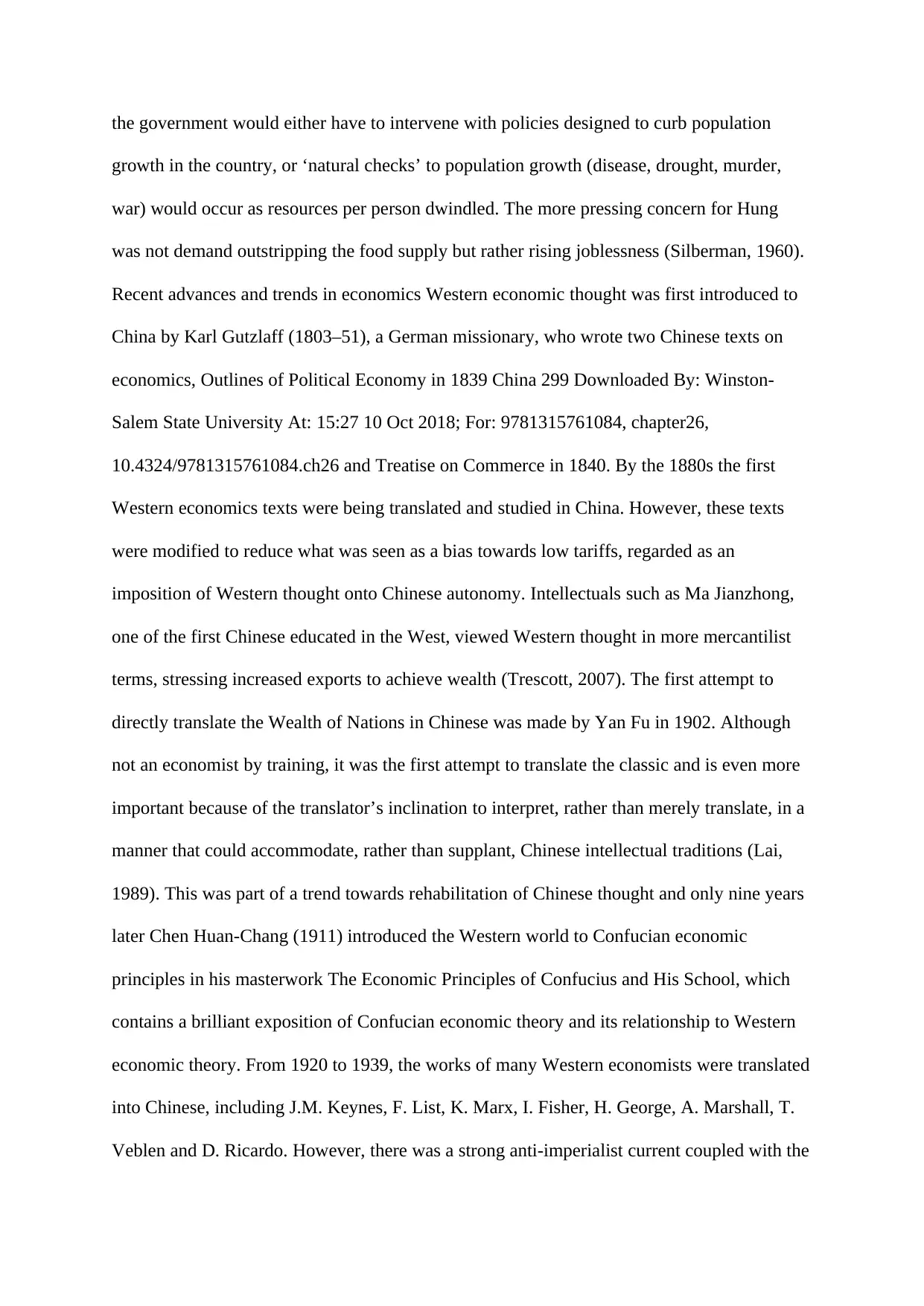
the government would either have to intervene with policies designed to curb population
growth in the country, or ‘natural checks’ to population growth (disease, drought, murder,
war) would occur as resources per person dwindled. The more pressing concern for Hung
was not demand outstripping the food supply but rather rising joblessness (Silberman, 1960).
Recent advances and trends in economics Western economic thought was first introduced to
China by Karl Gutzlaff (1803–51), a German missionary, who wrote two Chinese texts on
economics, Outlines of Political Economy in 1839 China 299 Downloaded By: Winston-
Salem State University At: 15:27 10 Oct 2018; For: 9781315761084, chapter26,
10.4324/9781315761084.ch26 and Treatise on Commerce in 1840. By the 1880s the first
Western economics texts were being translated and studied in China. However, these texts
were modified to reduce what was seen as a bias towards low tariffs, regarded as an
imposition of Western thought onto Chinese autonomy. Intellectuals such as Ma Jianzhong,
one of the first Chinese educated in the West, viewed Western thought in more mercantilist
terms, stressing increased exports to achieve wealth (Trescott, 2007). The first attempt to
directly translate the Wealth of Nations in Chinese was made by Yan Fu in 1902. Although
not an economist by training, it was the first attempt to translate the classic and is even more
important because of the translator’s inclination to interpret, rather than merely translate, in a
manner that could accommodate, rather than supplant, Chinese intellectual traditions (Lai,
1989). This was part of a trend towards rehabilitation of Chinese thought and only nine years
later Chen Huan-Chang (1911) introduced the Western world to Confucian economic
principles in his masterwork The Economic Principles of Confucius and His School, which
contains a brilliant exposition of Confucian economic theory and its relationship to Western
economic theory. From 1920 to 1939, the works of many Western economists were translated
into Chinese, including J.M. Keynes, F. List, K. Marx, I. Fisher, H. George, A. Marshall, T.
Veblen and D. Ricardo. However, there was a strong anti-imperialist current coupled with the
growth in the country, or ‘natural checks’ to population growth (disease, drought, murder,
war) would occur as resources per person dwindled. The more pressing concern for Hung
was not demand outstripping the food supply but rather rising joblessness (Silberman, 1960).
Recent advances and trends in economics Western economic thought was first introduced to
China by Karl Gutzlaff (1803–51), a German missionary, who wrote two Chinese texts on
economics, Outlines of Political Economy in 1839 China 299 Downloaded By: Winston-
Salem State University At: 15:27 10 Oct 2018; For: 9781315761084, chapter26,
10.4324/9781315761084.ch26 and Treatise on Commerce in 1840. By the 1880s the first
Western economics texts were being translated and studied in China. However, these texts
were modified to reduce what was seen as a bias towards low tariffs, regarded as an
imposition of Western thought onto Chinese autonomy. Intellectuals such as Ma Jianzhong,
one of the first Chinese educated in the West, viewed Western thought in more mercantilist
terms, stressing increased exports to achieve wealth (Trescott, 2007). The first attempt to
directly translate the Wealth of Nations in Chinese was made by Yan Fu in 1902. Although
not an economist by training, it was the first attempt to translate the classic and is even more
important because of the translator’s inclination to interpret, rather than merely translate, in a
manner that could accommodate, rather than supplant, Chinese intellectual traditions (Lai,
1989). This was part of a trend towards rehabilitation of Chinese thought and only nine years
later Chen Huan-Chang (1911) introduced the Western world to Confucian economic
principles in his masterwork The Economic Principles of Confucius and His School, which
contains a brilliant exposition of Confucian economic theory and its relationship to Western
economic theory. From 1920 to 1939, the works of many Western economists were translated
into Chinese, including J.M. Keynes, F. List, K. Marx, I. Fisher, H. George, A. Marshall, T.
Veblen and D. Ricardo. However, there was a strong anti-imperialist current coupled with the
⊘ This is a preview!⊘
Do you want full access?
Subscribe today to unlock all pages.

Trusted by 1+ million students worldwide
1 out of 20
Your All-in-One AI-Powered Toolkit for Academic Success.
+13062052269
info@desklib.com
Available 24*7 on WhatsApp / Email
![[object Object]](/_next/static/media/star-bottom.7253800d.svg)
Unlock your academic potential
Copyright © 2020–2025 A2Z Services. All Rights Reserved. Developed and managed by ZUCOL.


